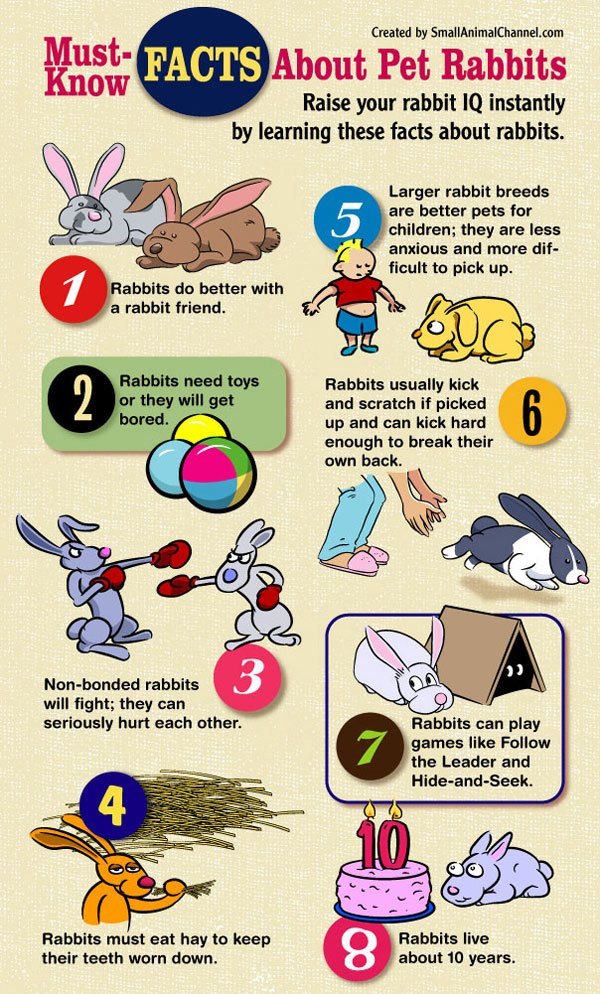A Guide to Basic Rabbit Care
Share

 While people don’t normally consider rabbits as companion animals, domestic rabbits are surprisingly affectionate and sociable. Just like cats and dogs, rabbits will follow you around, sit with you and beg for treats. They can even be clicker-trained to jump over obstacles and come when they’re called. But, just like dogs and cats, there are a number of things you need to consider before you decide to adopt a rabbit. (Be sure to take a look at our rabbit adoption resources before you consider purchasing one!)
While people don’t normally consider rabbits as companion animals, domestic rabbits are surprisingly affectionate and sociable. Just like cats and dogs, rabbits will follow you around, sit with you and beg for treats. They can even be clicker-trained to jump over obstacles and come when they’re called. But, just like dogs and cats, there are a number of things you need to consider before you decide to adopt a rabbit. (Be sure to take a look at our rabbit adoption resources before you consider purchasing one!)
[heading style=”modern-1-light” color=”#339933″ style_color=”#06192e” align=”left”]Housing Your Rabbit[/heading]
Different breeds of rabbits will have different housing requirements based on their size. While a dwarf rabbit only grows to about 2 pounds and needs only 3 square feet of space, Flemish giants can reach over 20 pounds and need 12 more square feet of room. Be sure to check what size requirements your rabbit needs and choose a cage that is appropriate. Many pet stores and websites sell well-made cages and even “bunny condominiums”. If you have the skill, you can even try building your own house for your rabbit. Several websites have instructions for doing this.
Do not buy any of the small plastic cages that are sold for ferrets, guinea pigs or chinchillas. While these cages are often advertised for rabbits, they are too small for anything but a dwarf rabbit, and even a dwarf rabbit will be cramped in one. Your rabbit should have enough room to hop around comfortably and stand up on its hind legs without touching the top.
[heading style=”modern-1-light” color=”#339933″ style_color=”#06192e” align=”left”]Outdoor vs. Indoor[/heading]
People commonly think of an outdoor hutch as a suitable place to keep rabbits. While this is often the choice for rabbits raised as livestock, pet rabbits do much better inside the house. Your pet will get more attention and more opportunity to interact with you, and it won’t have to cope with any of the raccoons, feral cats and other wild animal that would pass by its hutch out in the backyard.
If you do plan to keep you rabbit indoors and wish to let your rabbit hop around the house, you’ll need to “bun-proof” the area. Make sure that electrical wires are raised well off the ground and out of the rabbit’s reach. Gate off any areas that you don’t want your rabbit to enter, and make sure there aren’t any houseplants or other hazards on the floor that may be toxic to your rabbit.
[heading style=”modern-1-light” color=”#339933″ style_color=”#06192e” align=”left”]Litter Boxes for Your Rabbit[/heading]
People are often surprised to hear that rabbits can be litter box trained. When you bring your rabbit home and put it in its house, it will choose an area to use as the bathroom. If you put a litter box in that area, your rabbit will associate it with the bathroom and will learn to use the litter box. If you let your rabbit run around the house, you can put another litter box in another area of the house, and the rabbit will use that litter box as well.
Litter boxes should contain a layer of newspaper or newspaper bedding such as Yesterday’s News, which can be purchased in many pet stores. Horse bedding pellets can also be used, and has the advantage of being much cheaper than pet store brands, though you may have to buy in bulk. On top of this shallow bottom layer of newspaper or pellets, you should put a thick layer of timothy hay. Though pet stores do sell bags of timothy hay for rabbits, first cut and second cut bales of timothy hay are often sold at livestock or feed areas and are much cheaper if you have the room to store one. Rabbits will often sit in their litter boxes and munch on hay as they go; think of it as their version of “reading on the john”.
[heading style=”modern-1-light” color=”#339933″ style_color=”#06192e” align=”left”]Feeding Your Rabbit[/heading]
Rabbits need a diet of pellet food. Many pet stores sell different brands of Alfalfa or Timothy
based pellets. Avoid any brands with corn or seeds in them, as rabbits cannot process these foods.
Rabbits should also be provided with a constant source of Timothy Hay or Orchard Grass
to munch on for optimal health. Chewing on hay has a dual purpose; not only does it help to grind down the rabbit’s teeth, which are constantly growing, but it also helps to ensure proper digestion and prevent blockages.
Rabbits should also be given fresh green vegetables on a daily basis. Different rabbits have different preferences, but many will eat romaine lettuce, spinach, kale, parsley, beet tops, dandelions, carrot tops, swiss chard, bok choy, endive, broccoli, celery tops, mixed greens, broccoli rabe, pea sprouts, bean sprouts and clover. Do not give your rabbit potato skins or tomato greens, as these are toxic to rabbits. Iceberg lettuce should be avoided as well as it does not contain much nutrition and is very watery, which can give your rabbit diarrhea.
Many rabbits also enjoy treats such as carrots, graham crackers, fresh fruits such as apples, raspberries, strawberries, banana, and peaches, or dried fruit such as strawberry, papaya, dates, apricots, apple, banana chips and prunes. Do not give your rabbit too much banana, as it is binding and can block up your rabbits digestive system; too many prunes should be avoided for the opposite reason. Never give your rabbit anything containing dairy as they cannot digest it properly.
Be careful not to give your rabbit too many treats; obesity is on the rise, and it’s not just in humans anymore. If your bunny has become more of a fluffy ooze than a rabbit, limit the treats and be sure to provide plenty of hay and orchard grass.
 [heading style=”modern-1-light” color=”#339933″ style_color=”#06192e” align=”left”]Caring for Your Rabbit’s Teeth[/heading]
[heading style=”modern-1-light” color=”#339933″ style_color=”#06192e” align=”left”]Caring for Your Rabbit’s Teeth[/heading]
Rabbits need to chew on things frequently to grid down their front incisors, which are constantly growing. Providing your rabbit with timothy hay or orchard grass will help maintain good dental health; other good things that your rabbit will enjoy chewing include toilet paper tubes, cardboard boxes and natural wicker baskets. Many pet stores and online store also sell wooden chew sticks. If you have a tree with pinecones nearby, pick up a few clean ones for your rabbit; they enjoy playing with and chewing on them.
[heading style=”modern-1-light” color=”#339933″ style_color=”#06192e” align=”left”]Toys for Your Rabbit[/heading]
Rabbits are intelligent animals that need stimulation, much like any dog or cat. Pet stores often sell wooden toys or chew sticks for rabbits, as well as balls or stuffed toys. However, you don’t need to shell out big bucks for toys; many rabbits will be happy to play with and chew holes in toilet paper tubes, cardboard boxes, natural wicker baskets, natural pinecones, and even newspapers. Rabbits will also enjoy rolling around plastic balls and will be happy to play with any old toys or stuffed animals that are safe for infants.
[heading style=”modern-1-light” color=”#339933″ style_color=”#06192e” align=”left”]How to Pick Up Your Rabbit[/heading]
Rabbits generally do not like to be picked up. They are prey animals in the wild, and considering that hawks and other birds of prey will swoop down out of the trees to get them, their fear of heights and being grabbed is understandable. Rabbits are content to sit next to your care or snuggle with you on the floor, but if you need to pick up your rabbit to trim its nails, be sure to hold it against your body with one hand supporting its rump and one hand around its body. Never pick up a rabbit by the scruff of the neck as this can hurt them, especially with larger breeds.
[heading style=”modern-1-light” color=”#339933″ style_color=”#06192e” align=”left”]Rabbit Illnesses[/heading]
Rabbits are hindgut fermentors, meaning that they produce two kinds of poop. They will produce dry, round pellets that can easily be vacuumed up. These are ones that are commonly seen; rabbits may leave a few scattered around their house to mark it as their territory. Rabbits also produce a soft kind of poop called a caecotroph, which the rabbit will eat in order to digest again and get more nutrients out. This is completely normal and is actually a sign of a healthy rabbit.
Rabbits have a very delicate digestive system; if their gut becomes blocked or they stop eating, gas can build up and digestion can stop. This can be deadly in rabbits. For this reason, it is very important to have a vet that specializes in rabbits or exotic animals. If your rabbit stops eating and drinking, sits hunched up instead of relaxed, grinds its teeth constantly or stops producing poop, you should take it to the vet immediately, as this can be a sign of GI stasis.
Other common problems in rabbits include dental problems such as a chipped tooth; if your rabbit is constantly licking, grinding its teeth or drooling, you should have an experienced vet check it out. A good vet can also show you how to properly hold your rabbit and trim its nails.
[heading style=”modern-1-light” color=”#339933″ style_color=”#06192e” align=”left”]Committing To Your Rabbit[/heading]
Rabbits are sociable, intelligent pets that can live up to ten years; some breeds, such as Dutch rabbits, can reach 15 years of age with proper care. Do not purchase a rabbit if you cannot commit to care for it for this period of time.
Many people purchase rabbits for Easter without realizing the care and commitment they require. Thus, every year after Easter thousands of rabbits are abandoned in parks and on the side of the road. People think that a rabbit can survive fine in the wild, but the truth is that they are helpless on their own. Many are attacked by other animals- it’s easy to spot a white rabbit in a green field. Also, a rabbit that has been fed pellets all its life may not even know what kinds of plants it can eat outside.
Many pet stores do not sell rabbits simply because so many are abandoned. However, they will often team up with local shelters and rabbit rescue groups to find homes for adoptable rabbits. Be sure to check your area for rabbits to adopt; along with gaining a furry companion, you are giving an unfortunate rabbit a better life.
[heading style=”modern-1-light” color=”#339933″ style_color=”#06192e” align=”left”]Rabbit Facts[/heading]
This is a really great infographic from Small Animal Channel – we hope you’ll swing by and check them out!















